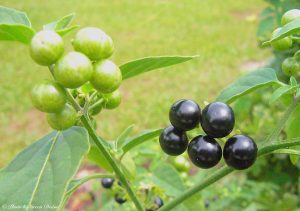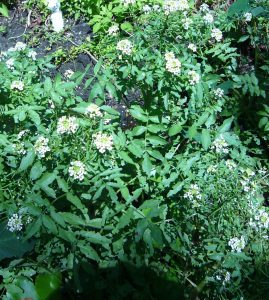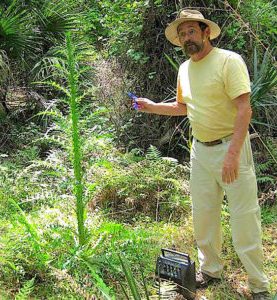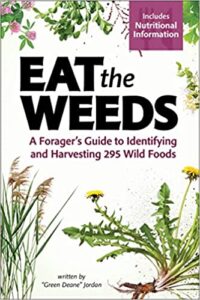
A long row of ready to eat Sea blite. Photo by Green Deane

Also ready for snacking is glasswort, still green at the beginning of its season. Photo by Green Deane
While some local fruits have missed their usual seasonal dates — a very dry spring is a possibile reason why — a delightful seasonal green, seablite (above) is flourishing. Mild and tasty, raw or cooked, it is a prime wild food positioned to become a commercial crop. A relative of Amaranth it is salt tolerant so seablite can be raised in unused tidal areas. We saw it in profusion Saturday in our foraging class at Ft. Desoto. Also in abundance was glasswort, tall and skinny, it’s not seasonal like seablite but edible all year tough it does get saltier as it ages.

Solanum americanum berries, photo by Green Deane
Ft Desoto also has something I have never see elsewhere, a persimmonhurst, a stand of persimmons. There was also a bit of mystery among the persimmons, one of the species in the “black nightshade complex.” Wild nightshades in the America have been controversial ever since European botanists first landed, and that hasn’t improve much in several hundred years. While I do eat ripe Solanum americanum berries often I usually don’t see solanum nigrum in my travels, except perhaps at Ft. Desoto and rarely in Ocala. Black nightshade fruit are usually larger than American nightshade fruit, and are dull when green and when black and ripe. The plant is sturdier also. We saw much of them at Desoto but eat didn’t many.

Foresteria berries, photo by Green Deane
Another semi-mystery at Ft. Desoto is a Forestiera, presumably F. segregata. The species gets scant mention in ethnobotanical literature with the eminent Dr. Daniel Austin managing only a paragraph in his 900-page book Florida Ethnobotany. The blue fruit has been used for ink production and if one’s timing is good they can have non-offensive taste. A distant relative of olives one species in the genus reportedly has been eaten, Foresteria neo-mexicana aka foresteria pubescens var. pubescens.. I have brined the berries — like olives — and found them palatable but a lot of work for little payoff.

Watercress. Photo by Green Deane
Sunday in Melbourne, we saw, and tasted, what is left of this year’s watercress crop (left, Nasturtium officinale, left) A common wintertime find in streams and ditches in Central Florida it used to be a major commercial crop a century ago here and in Huntsville Alabama. While local stories say the species was first cultivated in Sanford, Florida, then moved to Alabama others say it started in Alabama and in the early 1900s moved to Florida. At one time Sanford Fl. was a major agricultural area of the state. It is there where the first railroad was built terminating in St. Petersburg (not far from Ft. Desoto.) If one wants to eat wild watercress raw it is best to harvest it immediately down stream from a spring or boil and cook it to kill any liver flukes on the leaves. As the deadly water hemlock likes the same location harvest watercress carefully. One water hemlock leave can kill an adult. There is no antidote.

Foraging classes are held rain or shine, heat or cold. Photo by Nermina Krenata
Nice weather might prevail for foraging classes this weekend, Saturday mid-state at winter Park and Sunday near the west coast at Eagle Lake Park, Largo.
Saturday, June 1st, Mead Garden: 1500 S. Denning Dr., Winter Park, FL 32789. Meet at the bathrooms. 9 a.m. to noon.
Sunday, June 2nd, Eagle Park Lake,1800 Keene Road, Largo, FL 33771. Meet at the pavilion near the dog park. 9 a.m. to noon.
For more information on these classes, to prepay or sign up go here. The cost is $30 per adult (the class is usually three hours long and examines five-dozen or so species.) If cost is a hardship email me at: Green Deane@gmail.com.

Green Deane Forum
Tired of Facebook and want to identify a plant? The Green Dean Forum is up and running again. Have you come to dislike Facebook, then join us on the forum. Perhaps you’re looking for a foraging reference? You might have a UFO, an Unidentified Flowering Object, you want identified. On the Green Deane Forum we — including Green Deane and others from around the world — chat about foraging all year. And it’s not just about warm-weather plants or just North American flora. Many nations share common weeds so there’s a lot to talk. There’s also more than weeds. The reference section has information for foraging around the world. There are also articles on food preservation, and forgotten skills from making bows to fermenting food.

You get the USB, not the key.
172-video USB would be a good end of spring present and is now $99. My nine-DVD set of 135 videos has been phased out. The USB videos are the same videos I have on You Tube. Some people like to have their own copy. Most of the 172 USB videos have to be copied to your computer to play. If you want to order the USB go to the DVD/USB order button on the top right of this page. That will take you to an order form.

Now in second printing.
274 plants, 367 pages, index, nutrition charts and color photos. It’s available in many locations including Amazon. Most of the entries include a nutritional profile. It can also be ordered through AdventureKeen Publishing.
This is weekly newsletter #603. If you want to subscribe to this free newsletter you can find the sign-up form in the menu at the top of the page.
To donate to the Green Deane Newsletter click here.

